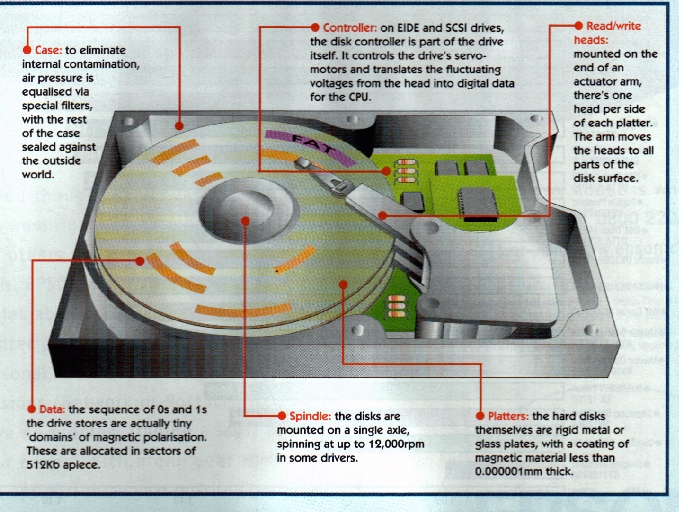
How A Hard Drive Works |

|
A hard drive is made of one or more platters, consisting of a substrate, often glass, coated with a magnetic substance.These generally rotate at speeds of between 4,000 and 7,200 rpm for IDE disks, whilst SCSI can spin as fast as 12,000 rpm. Each platter is read from and written to by a magnetic head, similar to those on a tape recorder.This is positioned a fraction of a millimetre above the platter. the flow of air from the spinning disks prevents the heads from touching the platters |
|
|
until the hard drive has completelyspun down. Keeping the heads of the platters requires great precision, so a hard drive is factory sealed and dust free. a small particle of dust could cause a head to 'crash', touching the disk and scrapping off the magnetic coating. The heads are mounted on arms that move them to and from the central spindle in the spaces between the platters. The arms are moved by the head actuator, which contains a magnetic coil similar to that used by a loudspeaker to vibrate its cone. this can produce very rapid motion. Each platter is double sided and divided into tracks. These are concentric circles around the central spindle. Tracks physically above each other on the platters are grouped together into cylinders which are then further subdivided into sectors. The concept of cylinders is important, since cross-platter information in the same cylinder can be accessed without having to move the heads. When you read and write data, the operating system works out where the data is on the disk. It first reads the FAT (file allocation table) at the beginning of the partition. This tells the operating system which sector on which track to find the data. The OS also subdivides each sector into clusters, so the FAT contains information as to which cluster in the sector contains the data as well. With this information, the head can then read the requested data. More often than not, the next set of data to be read is sequentially located on the disk. For this reason, hard drives contain between 64Kb and 4Mb cache memory to store all the information in a sector or cylinder in case its needed. This is very effective in speeding up both throughput and access times. A hard drive also requires servo information, which provides a continuous update on the location of the heads. This can be stored on a seperate platter, or it can be intermingled with the actual data on all the platters. a seperate servo platter is more expensive, but it speeds up access times, since the data heads won't need to waste any time sending servo information. However, the servo and data platters can get out of alignment due to changes in temperature. To prevent this, the drive constantly rechecks itself in a process called thermal recalibration. During multimedia playback this can cause sudden pauses in data transfer, resulting in stuttered audio and dropped video frames. Where the servo information is stored on the data platters, thermal recalibration isn't required. For this reason the majority of drives have moved over to embedding the servo information with the data.
|